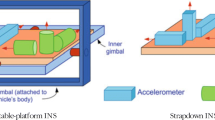Abstract
The output of an inertial measuring unit contains the combined effect of vehicle acceleration, accelerations due to the reference system, gravitational attraction, calibration and alignment errors, and measuring noise. The separation of individual effects from the total output is the task of modelling. Differences in the existing models are mainly due to the treatment of system errors and of the anomalous gravity field.
The paper discusses the state space formulation as a general approach to represent errors of a dynamic system and describes its application to the modelling of an inertial system. Complications due to the effects of the anomalous gravity field are discussed and possible solutions are indicated. Finally, the models in the existing inertial survey systems are compared and implementation requirements for survey applications are outlined.
Sommaire
Les mesures effectuées par l’unité de mesure inertielle continnent les effets de l’accélération du véhicule et de celle due au système de référence, de l’attraction gravitationnelle, des erreurs de calibrage et d’alignement, et finalement du bruit de fond. La séparation de chacun de ces effets sur les mesures est le sujet de la modélisation. Les différences dans les modèles existant sont principalement dues au traitement du système d’erreurs et des anomalies du champ de gravité.
La communication discute de la formulation du vector d’erreurs comme approche générale pour la représentation d’erreurs dans un système dynamique et décrit son application dans la modélisation d’un système inertiel. Les complications dues aux effets des anomalies du champ de gravité sont discutées et des solutions possibles sont indiquées. Enfin, les modèles dans les présents systèmes inertiels d’arpentage sont comparés et les exigences pour les applications en arpentage sont soulignées.
Similar content being viewed by others
References
K.R. BRITTING (1971):Inertial Navigation Systems Analysis. Wiley-Interscience, New York.
P.A. CROSS and J.P. WEBB (1981):Post-Processing Experiments with FILS 2 Test Data. Proceedings of the “Second International Symposium on Inertial Technology for Surveying and Geodesy”, June 1–5, 1981, Banff, Canada.
P. EYKHOFF (1974):System Identification-Parameter and State Estimation. John Wiley and Sons, London. Second printing 1977.
A. GELB (1974):Applied Optimal Estimation. The M.I.T. Press, Cambridge, Mass. Fourth printing 1978.
E.W. GRAFAREND (1981):From Kinematical Geodesy to Inertial Positioning. Proceedings of the “Second International Symposium on Inertial Technology for Surveying and Geodesy”, June 1–5, 1981, Banff, Canada.
HONEYWELL (1980):Operation Manual for DMA/IPS-2 Inertial Survey System. Honeywell, Avionics Division, St. Petersburg, Florida.
J.R. HUDDLE (1976):Navigation to Surveying Accuracy with an Inertial System. Bicentennial National Aerospace Symposium of the Institute of Navigation at Warminster, Pennsylvania.
M. KAYTON (1960):Coordinate Frames in Inertial Navigation. Doctoral Thesis, Massachusetts Institute of Technology.
G. LACHAPELLE and K.P. SCHWARZ (1980):Empirical Determination of the Gravity Anomaly Covariance Function in Mountainous Areas. The Canadian Surveyor, Vol. 34, No. 3, pp. 251–264.
I.I. MUELLER (1980):Reference Coordinate Systems for Earth Dynamics: A Preview. Proc. IAU Colloq. 56 on Reference Coordinate Systems for Earth Dynamics, Sept. 8–12, Warsaw, Poland, E.M. Gaposchkin and B. Kolaczek, eds., D. Reidel.
K.P. SCHWARZ (1980):Gravity Field Approximation using Inertial Survey Systems. The Canadian Surveyor, Vol. 34, No. 4, pp. 383–395.
K.P. SCHWARZ and M. GONTHIER (1981):Analysis of the Heading Sensitivity in the Litton Inertial System. Proceedings of the “Second International Symposium on Inertial Technology for Surveying and Geodesy”, June 1–5, 1981, Banff, Canada.
F.C. SCHWEPPE (1972):Uncertain Dynamic Systems, Prentice Hall, Englewood Cliffs, New Jersey.
M. VAN DER HERRENWEGEN (1980):Practical Results with the FILS Inertial Surveyor. Institut Geographique National, Brussels.
V.C. WONG and K.P. SCHWARZ (1979):Investigations on the Analytical Form of the Transition Matrix in Inertial Geodesy. Technical Report No. 58, The University of New Brunswick, Fredericton.
V.C. WONG (1981):A Kalman Filter/Smoother for the Ferranti Inertial Land Surveyor System. Proceedings of the “Second International Symposium on Inertial Technology for Surveying and Geodesy”, June 1–5, 1981, Banff, Canada.
Author information
Authors and Affiliations
Rights and permissions
About this article
Cite this article
Schwarz, K.P. A comparison of models in inertial surveying. Bull. Geodesique 55, 300–314 (1981). https://doi.org/10.1007/BF02527054
Received:
Accepted:
Published:
Issue Date:
DOI: https://doi.org/10.1007/BF02527054




